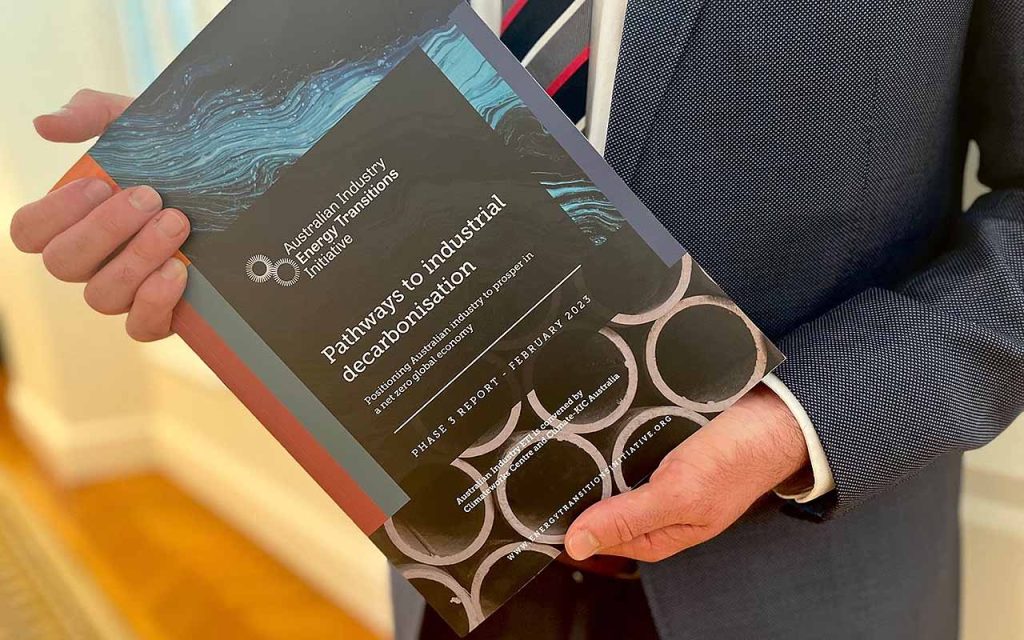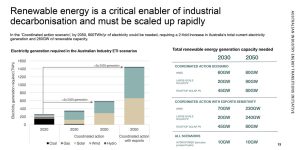‘A moment of opportunity’ to slash industrial emissions
Australia could reduce key industry emissions by 92 per cent by 2050, according to a new report. It won’t be easy, but it will be worth it.

A new Australian Industry ETI report says Australia could cut annual greenhouse gas emissions in five key industrial sectors by 92 per cent by 2050, based on 2020 levels.
Widely supported by industry partners, the report outlines an ambitious pathway to reducing emissions in line with limiting global warming to 1.5 degrees.
The report says a “coordinated action scenario” would need substantial government incentives to complement industry leadership. All told, the investment required could total around $625 billion, or more than $20 billion annually for 30 years.
But the rewards could be huge: a competitive advantage for Australian green industries; new export sectors; sustained market share in existing markets; up to 1.35 million jobs; all with far less land-based sequestration than would be required under alternative scenarios.
The findings are published in the third and final phase of research from the Australian Industry Energy Transitions Initiative (Australian Industry ETI), Pathways to Industrial Decarbonisation.
“This is a moment of opportunity,” said Australian Industry ETI Chair, Chancellor of Monash University, former CSIRO Chairman and former Australian of the Year Simon McKeon AO.
“Action is needed now to lay the foundations, capitalise on the opportunities and avoid more costly emissions reduction measures in the future,” he said.
What is the Australian ETI

The Australian ETI, established in 2020 with the help of $300,000 ARENA funding, draws together 18 industry partners.
Collectively, those industry partners account for approximately 32 percent of the value of the ASX 100.
In monetary terms, the five key industrial supply chains the ETI addresses account for 17.3 per cent of Australia’s GDP. Those supply chains are: iron and steel; aluminium; other metals; chenicals; and liquid natural gas (LNG)
Exports are worth more than A$236 billion each year, more than 10 times the projected annual cost of decarbonisation.
In people terms, the same supply chains directly employ an estimated 414,000 people.
But those supply chains also contribute an estimated 25 per cent of Australia’s annual emissions.
Following establishment of the ETI, ARENA provided a further $2 million funding to support research, analysis and industry engagement to identify ways to decarbonise these major supply chains.
Two not-for-profits, Climateworks Centre and Climate-KIC Australia, have now delivered a total of three reports.
The first, Setting Up Industry for Net Zero, released in June 2021 focused on establishing the current state of play in industrial decarbonisation and future possibilities for Australian industries.
The second, Setting Up Industrial Regions for Net Zero, published in June 2022, examined the potential for expanding decarbonisation activities in five existing industrial zones in Australia.
Third and final phase

This third phase identifies five objectives for Australian industries to achieve 92 per cent emissions reductions.
- Set a strong, clear, enduring framework with a net zero emissions goal to align industry, finance and government.
- Transition to the large-scale, cost-competitive, renewable energy system of the future.
- Accelerate development and demonstration of the emerging technologies needed.
- Drive deployment of low-carbon solutions, reduce barriers and support investment towards the transition.
- Develop integrated net zero emissions industrial regions, supply chains and energy network solutions.
This scenario would require at least doubling Australia’s renewable energy supply by 2050. If Australia is to become a global renewable energy and products exporter, renewable energy supplies must grow five-fold.
Climateworks CEO Anna Skarbek says the ETI reports show the transition will require considerable investment in modernising Australia’s industrial regions and energy systems.
“This three-year program has shown that transitioning heavy industries in a carbon intensive economy like Australia is a challenge that will require a transformational shift,” she said.
“This represents an investment … that over a 30-year period, equates to roughly A$20.8 billion per year.
“To put this into context, it is significantly less than the value of the exports of the five supply chains in focus for the Australian Industry ETI,” she said.
Are there alternatives courses of action?
The report also investigated alternative scenarios.
An “Incremental” scenario envisages a lack of domestic policy, other incentives and industry action. The ETI report characterises it as “a technology-led, cost-driven transition, with limited action on climate”.
Such an approach would not realise net-zero emissions by 2050, would not mitigate global warming, and would see a negative global response to Australian industries.
An “Industry-led” scenario in which industry demonstrates leadership and ambition on climate but in a relatively unsupportive domestic context.
This approach would have a high (83 per cent) chance realising a trajectory consistent with a 2-degree warming scenario. However it would leave Australia lagging on technological innovation and developing new markets. It would also mean Australia would not meet its Paris Agreement goals.
Coordinated action
The “Coordinated action” scenario would see Australia’s industries rapidly decarbonise. Emissions would be in line with a 63 per cent chance of limiting global warming to 1.5 degrees.
The speed and scale of the transition would also help Australia establish a competitive advantage in green industries. That could lead to new export markets and sustained share in existing markets.
The report is supported by companion technical and jobs reports, which supplement the main report with in-depth modelling and analysis.
ARENA CEO Darren Miller said the reports provide valuable insights into the pathway to reducing emissions from industry.
“We know we face a significant challenge in reducing emissions from heavy industrial processes. Through this collaboration and vital work, the Australian Industry ETI is showing what is needed to address this imperative and work towards the common goal of zero net emissions.
“Close industry collaboration is essential in these hard-to-abate sectors. The Australian Industry ETI provides a blueprint for cooperation. It’s a testament to what can happen when business, finance, government and the not-for-profit sector come together.”
LIKE THIS STORY? SIGN UP TO OUR NEWSLETTER

ARENA